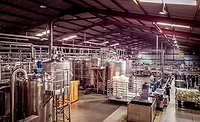Optimizing the Bottom-Line: Advances in PCR Enrichment

Noted for his pioneering work in advancing the seven principles of the Hazard Analysis & Critical Control Points (HACCP) food safety program, Cargill, Inc.'s Dr. William Sperber says there are just three critical points to consider when adopting new food microbiology detection methods: accuracy, rapidity and cost.
"First, the method must be accurate," says Sperber, Senior Corporate Microbiologist with the global food and agricultural processing and distribution company. "We want it to have as few false-positives as possible and no false-negatives. Secondly, we must consider the time involved in conducting the method and the speed-to-result because time is money. The last consideration is cost, both the capital cost of the instrumentation and the expense cost of disposables, but this is a distant third compared to accuracy and time to result."
For Cargill, whose worldwide food industry businesses supply products used in food production in 59 countries, including meat and poultry, grain, flour and oilseeds, these three criteria played a significant role in its decision two years ago to adopt the DuPont Qualicon BAX® system, the automated polymerase chain reaction (PCR) screening method that detects target bacteria in raw ingredients, finished food products and environmental samples. Initially, the company was intrigued with the commercialization of PCR technology for pathogen detection in foods, Sperber says, because it appeared to hold up against the first two criteria.
"We saw four years ago that PCR offered the possibility of detecting lower numbers of cells in a quicker time because of the artificial amplification of the DNA. It also offered the prospect of much greater accuracy because you could directly detect a certain DNA sequence of the target pathogen. We waited to adopt the technology until an automated version became available about two years ago. We're so impressed that we've applied the BAX® system in 15 of Cargill's pathogen laboratories worldwide, including those in our meat and poultry plants in the U.S."
Time-Saving Innovation Translates to Cost-Savings
As Sperber indicates, in just a few years PCR technology developers have been able to automate these rapid detection systems such that a method once used exclusively in clinical applications is fast becoming a well-accepted tool in the food industry. But with increasing regulatory directives and mandates that require more pathogen testing, particularly in the meat and poultry industry, the need for an even faster time to result has become paramount. "There is now severe regulatory pressure to test for one of three target pathogens--E. coli O157:H7, Salmonella, or Listeria monocytogenes--and time is literally money, so the quicker you can do a test, the better," he says.
Peter Mrozinski, Ph.D., DuPont Qualicon's Director of R&D and Operations, agrees that this pressure on the meat and poultry industry proved a catalyst for the global food diagnostics company's latest innovation in rapid PCR technology. By optimizing its enrichment broths for PCR, the DuPont Qualicon team has dramatically shortened enrichment times--in the case of its new E coli O157:H7 media, for example, the enrichment time has been reduced from 20 hours to 8 hours--to take advantage of the selectivity and sensitivity attributes of PCR.
"Current enrichment broths are designed for traditional and other rapid methods, which usually require a lengthy enrichment in selective broths that provide a growth environment for target cells while inhibiting the growth of background bacteria," explains Mrozinski. "The greater sensitivity of PCR doesn't require long and selective enrichments because it can detect the DNA of the target even at very low levels, despite the level of background bacteria. What we've learned is that we can 'tune' the enrichments by reducing their selectivity, and this translates to a reduction in the enrichment times because we're not inhibiting the growth of the target organisms."
With the advance of enrichment broths that are optimized for PCR methods, the bottom-line effect of these shorter enrichments is an even quicker time to result. That kind of bottom-line innovation is just what the industry needs, says Sperber. "We are convinced that with automated PCR we get complete accuracy in a reasonable time and at a reasonable cost--which meets all of the criteria I mentioned. But this technology has also exceeded our expectations, both in terms of the tremendous time-savings brought about through DuPont Qualicon's successful efforts in optimizing the enrichment broths, and one benefit that we didn't anticipate: a greater-than-expected reduction in labor costs.
"In the first of Cargill's pathogen labs to adopt this technology, we found that our labor costs went down 67%; literally, one person was able do the work of three just in terms of testing samples. So automated PCR is a very efficient approach because there is very little hands-on time required. That was a very positive surprise for us, and we were able to use the additional time to employ our laboratory staff to perform activities more useful than product testing."
Mrozinski adds that his company is now actively working on optimizing the enrichments for both Salmonella and Listeria, with a view toward drastically reducing the enrichment times for these target pathogens, as well. "This is one of the most exciting developments in improving rapid pathogen detection to date. It could even redefine what we mean by the term 'rapid.'"
www.qualicon.com
Looking for quick answers on food safety topics?
Try Ask FSM, our new smart AI search tool.
Ask FSM →








